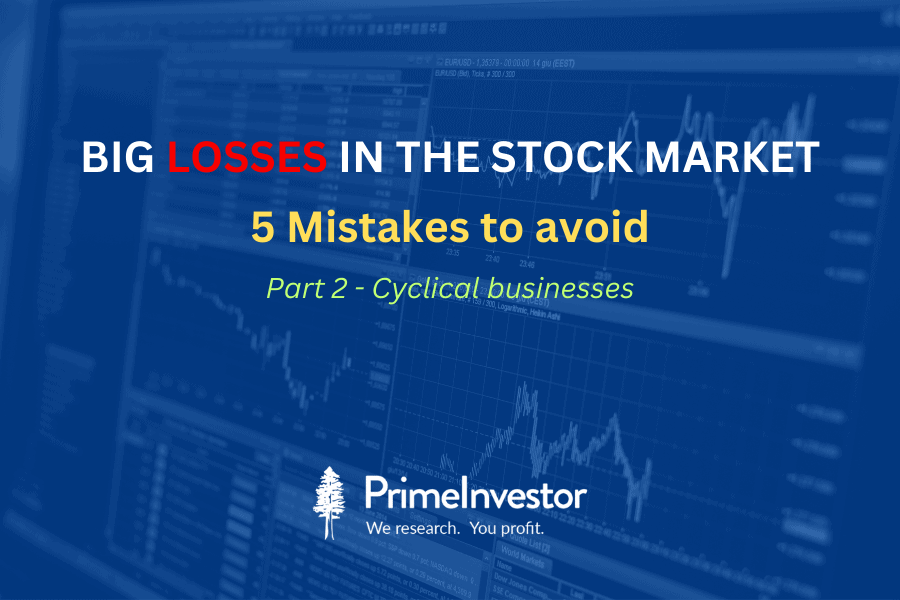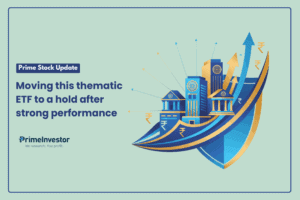This is the second part of a 4-part series where we discuss the five mistakes that lead to big losses in your equity investments and how to avoid them.
The 4-part series is as follows:
- Big losses from rich valuation
- Losses from cyclical businesses ( this article)
- Losses from low quality businesses
- Losses from seeming turnaround stories and no-growth businesses

Loss from cyclical businesses
Companies with cyclical businesses have the following characteristics:
- They typically sail with the fortunes of the sector in which they operate.
- They make healthy profits during up cycles, and land in losses or have very low profits during down cycles.
- The demand supply situation in the market determines the pricing environment and companies have little ammunition to protect their margins.
- Capacity utilisation plays an important role in the profitability of these companies in sectors with high fixed costs.
Generally, commodity producers such as cement, steel, chemicals, oil and sugar to name a few fall under cyclical businesses. Then come the commercial vehicle, banking, real estate, auto component makers and capital equipment makers – whose fortunes are tied to the general growth of the economy.
Some of the popular companies with cyclical businesses that fell victim in the previous economic down cycle include Unitech, HDIL, Jaiprakash Associates, IVRCL, Gammon, GVK, Bhushan Steel, Binani Cement, Crompton Greaves, BGR Energy, Sintex industries and Amtek Auto.
Let’s look at a few examples on how these cycles play out.
JP Associates: An unending debt spiral
While Jaiprakash Associates started off as a construction company that was doing well with projects, its foray into real estate and cement during the height of economic boom in 2008 landed it into trouble as demand collapsed in both the sectors. Debt ballooned to Rs.62,000 crores by 2012 as it borrowed to invest in real estate, cement, and energy assets.
As trouble mounted, it got rid of its cement assets (good asset) first in 2017 for which Ultratech emerged as a buyer for a consideration of Rs.17,000 crore. In terms of capacity, it was a mammoth 21 million tonnes. To put in perspective, the 6th largest cement player today has 22 million tonnes capacity.
Bankers also pushed for the deal as there were not many players who could buy large assets at that time, which also turned valuations against JP’s favour. But what JP Associates sold was the goose that laid golden eggs. A look at the P&L of JP Associates post cement asset sale in 2017 reveal that its losses were only mounting up year after year.
Meanwhile, the stock still attracted attention of turnaround investors in 2017 even when it was selling its golden goose to Ultratech.
As it recently defaulted on nearly Rs.4,000 crore of debt in 2023, the firm has decided to sell its remaining cement assets to Dalmia Bharat for Rs.5,666 crore. It’s flagship real estate assets (housed under Jaypee Infratech) have also gone out of its hands through NCLT resolution just recently.
While good assets were being taken away, what was left was the unresolved debt and inefficient assets leading to a downward spiral for its investors, losing 98% from its peak.
Ramkrishna Forgings: A scary roller coaster ride
Ramakrishna Forgings may seem like the poster boy of the small cap bull market at present, but it has had a roller coaster ride in the past with over 50% corrections - twice!

Ramkrishna Forgings is an ambitious, capable and the second largest forging company behind Bharat Forge. But it has more often pursued aggressive expansion using debt and was caught on the wrong foot twice as demand collapsed and the stock nosedived.
In bad years, it was a close call between the company’s cash flows and its commitment on annual debt repayment plus interest cost as can be seen from table (take annual debt payment as 1/10th of total debt, just for understanding) below.
Fortunately, everything seems to be working for it now with both domestic and US truck markets doing well while getting a big opening in Railway orders.
We added the stock in our Auto++ smallcase, at its 52 week low, with lowest allocation of 5% as it could go either way due to its debt heavy balance sheet. The risk of business cyclicality combined with debt prevented us from taking it to our PrimeStock recommendation. But 2023 proved to be a bumper year for the company and the stock is in a bull run, with cyclicality risks hidden under the carpet of bull market. We made the exit when the going was good 😊
PSU banks: The great disappearance
If there was a compelling investing story in the market during 2007-10, it was the PSU banks. They were considered the best investment bets in the aftermath of global financial crisis as they remained unscathed.
In FY09 and FY10 this segment showed stellar financial performance while being available for a steal in terms of valuations (single digit PE, 1-1.5 times price to book value and 4-5% dividend yields).
As the aftereffects of global financial crisis started to play out in the form of collapse in global commodity prices, slowdown in real estate sector and slowing exports, market participants sensed trouble. PSU banks with wider exposure to economic sensitive sectors fell victims to the economic cycle.
The next 10 years since 2010 turned out to be a nightmare for this segment with NPAs and losses mounting from 2016 to 2019. It started with NPAs in steel, power and real estate sectors and then spread across to many other smaller sectors as well including auto components, capital goods and textiles.
As they say, all bad loans are made at the best of times. This was the case with PSU bank books.
From record profits in FY09 & FY10, they all slipped into losses during FY16-FY19.
Most of the PSU banks have lost anywhere between 50-80% from their 2010 stock price till now, stealing away a lot of investors wealth.
For example, PNB is still one fourth of its 2010 price. But PNB today is a combination of PNB, Oriental Bank and United bank, which were all separately listed then.
The only PSU bank in which investors seem to have made positive return since 2010 is SBI while the disappeared ones include Syndicate Bank, Corporation Bank, Dena Bank, Vijaya Bank, Oriental bank of commerce, Allahabad bank, Andhra bank and United bank.
All said, what happened in PSU banks was a classic case of downturn and consolidation. While it is not easy for an investor to anticipate what may go wrong, at least staying with the leaders would have definitely helped. Larger players in cyclical businesses at least have the wherewithal to absorb shocks better.
What checks to apply while investing in companies with cyclical businesses?
#1 Do a serious check on capital allocation decisions in cyclical businesses
Capital allocation decision is the single most important thing to watch out for in a cyclical business. Quite often, even seasoned companies get it wrong with their own industry’s cycles. They jump into hasty acquisitions, do capex, attempt diversification, etc. at the peak of a cycle and suffer through down cycle. At the end, bankruptcies and consolidation happen and strong players emerge stronger in the next cycle. On the other hand, prudent players do capex when the sector is in a downturn, preparing for the next uptick.
Let’s look at some of the major capital allocators in the previous cycle and what impact it had on their shareholders.
1A A case of poor capital allocation
JSW Steel would not have overtaken Tata Steel in market cap, had the latter done its math right!
Tata Steel’s equity share capital was less than half of what it is today, before acquisition of Corus. It had very little debt too. Had the acquisition not happened and Tata Steel had put all the money in its India business, its share price would have been 6X of what is today and far above JSW Steel in market cap.
The Rs.58,000 crore it spent for Corus acquisition hasn’t paid back and worse, only swallowed more capital from Tata Steel during down cycle. Here’s the quick math:
1B A case of well-timed allocation
A decade ago in 2010, Ultratech and ACC were of similar size at 30 million tonnes (mt) cement capacity. But a decade later, Ultratech today is a leader with over 110 mt capacity while ACC is still at 33mt. The big change happened when Ultratech bid for 5 cement plants of Jaiprakash Associates at one go for close to Rs.17,000 crore amid banking sector crisis in 2017.
It was a deal that neither the owner of the assets nor the creditors could let go of, amid that banking crisis. And Ultratech turned out to be a 10 bagger from its 2010 price as it bough these assets at a distress price. So it was a case of finding opportunity in a downturn and turning a distress into a fortune. This typically happens only when cycles turn – in the economy (as was the case then) or a sector (banking sector crisis) bites the dust.
#2 Valuation rule is different in cyclical businesses
If you are someone looking at PE ratio as a valuation metric, then the approach should be to 'buy at high PE and sell at low PE' when it comes to cyclical, specifically commodity plays.
This is because during period of weak earnings (or even loss) the PE becomes inflated (as the denominator is low or negative) while stocks may not fall below their book value or replacement cost (in cement, steel, etc.).
But when the cycle turns up, profits start increasing. Buoyed by strong earnings, stock prices rally well past their book value or replacement cost. But the periods of very high profits won’t sustain as companies rush to put additional capacities. So, the PE ratio will contract and look extremely attractive at the peak of earnings cycle. And that is the best time to sell commodity stocks. Yes, that’s how it works!
To read from recent examples of steel majors, they were trading at 4-6 PE on their 2022 earnings while now they are trading at 17-51 times. Earnings peaked out in FY22 and sharply contracted in FY23 (Tata steel and JSW steel reported losses in Q2/Q3 FY23)
Likewise, cement companies reported their best earnings in FY21 & FY22 and put a bad show in FY23. The best earnings phase was followed by a major IPO, that of Nuvoco Vistas. While their PE ratios look optically high now, it will come down as earnings recover in FY24.
To sum up:
- The most important thing to be aware of, while betting on cyclical businesses, is the cycle itself. And to play it safe, it is best to go with the leaders in case of commodities. They are also the ones with muscle to make well-timed acquisitions besides the ability to absorb rude shocks in the sector or economy.
- The second important thing when investing in cyclical businesses is to identify and go with companies with prudent capital allocation plans. Only those that dare to acquire companies at the bottom of a cycle and prudent enough to conserve capital at the peak of cycle can emerge stronger after each cycle.
- It is important to play the valuation game differently when it comes to commodity companies as explained above.
The securities quoted are for illustration purposes only and are not recommendatory.





